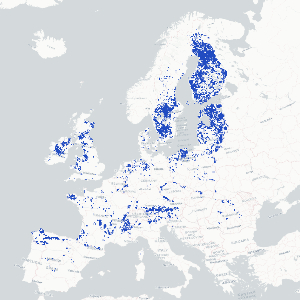You are viewing the Initial Version, the most recent version of this dataset.
1 version(s) available
Date of publication: February 12, 2024
Version 1
Date of publication: February 12, 2024
Type of change:
Description:

Distribution of European habitat types of the Habitats Directive (2018)
by Martina Marei VitiDistribution of European habitat types as derived from the Article 17 (Annex I) reporting of the Habitats Directive 92/43/EEC for the period 2013-2018. The dataset contains gridded habitats distribution data (10 km grid cells), as reported by EU28 Member States. ...(continue reading)
DOI 10.25829/hn9gx7Citation
Viti, M., Quoß, L. (2024). Distribution of European habitat types of the Habitats Directive (2018) (Version 1) [Dataset]. German Centre for Integrative Biodiversity Research. https://doi.org/10.25829/hn9gx7HabitatsEuropeHabitats Directive
| Entities |
|---|
| Bushes with Pinus mugo and Rhododendron hirsutum (Mugo-Rhododendretum hirsuti) |
| Active raised bogs |
| Mountain hay meadows |
| Lowland hay meadows (Alopecurus pratensis, Sanguisorba officinalis) |
| Alluvial meadows of river valleys of the Cnidion dubii |
| Hydrophilous tall herb fringe communities of plains and of the montane to alpine levels |
| Molinia meadows on calcareous, peaty or clayey-silt-laden soils (Molinion caeruleae) |
| Pannonic loess steppic grasslands |
| Species-rich Nardus grasslands, on siliceous substrates in mountain areas (and submountain areas, in Continental Europe) |
| Semi-natural dry grasslands and scrubland facies on calcareous substrates (Festuco-Brometalia) (* important orchid sites) |
| Rupicolous pannonic grasslands (Stipo-Festucetalia pallentis) |
| Alpine and subalpine calcareous grasslands |
| Calaminarian grasslands of the Violetalia calaminariae |
| Rupicolous calcareous or basophilic grasslands of the Alysso-Sedion albi |
| Alpine Larix decidua and/or Pinus cembra forests |
| Natural dystrophic lakes and ponds |
| Subalpine and montane Pinus uncinata forests (* if on gypsum or limestone) |
| (Sub-) Mediterranean pine forests with endemic black pines |
| Pannonic salt steppes and salt marshes |
| Pannonic inland dunes |
| Oligotrophic to mesotrophic standing waters with vegetation of the Littorelletea uniflorae and/or of the Isoeto-Nanojuncetea |
| Juniperus communis formations on heaths or calcareous grasslands |
| Natural eutrophic lakes with Magnopotamion or Hydrocharition - type vegetation |
| Subcontinental peri-Pannonic scrub |
| Alpine rivers and the herbaceous vegetation along their banks |
| Alpine rivers and their ligneous vegetation with Salix elaeagnos |
| Water courses of plain to montane levels with the Ranunculion fluitantis and Callitricho-Batrachion vegetation |
| Rivers with muddy banks with Chenopodion rubri p.p. and Bidention p.p. vegetation |
| European dry heaths |
| Depressions on peat substrates of the Rhynchosporion |
| Hard oligo-mesotrophic waters with benthic vegetation of Chara spp. |
| Euro-Siberian steppic woods with Quercus spp. |
| Degraded raised bogs still capable of natural regeneration |
| Tilio-Acerion forests of slopes, screes and ravines |
| Bog woodland |
| Alluvial forests with Alnus glutinosa and Fraxinus excelsior (Alno-Padion, Alnion incanae, Salicion albae) |
| Riparian mixed forests of Quercus robur, Ulmus laevis and Ulmus minor, Fraxinus excelsior or Fraxinus angustifolia, along the great rivers (Ulmenion minoris) |
| Sub-Atlantic and medio-European oak or oak-hornbeam forests of the Carpinion betuli |
| Pannonian woods with Quercus pubescens |
| Medio-European limestone beech forests of the Cephalanthero-Fagion |
| Illyrian Fagus sylvatica forests (Aremonio-Fagion) |
| Illyrian oak-hornbeam forests (Erythronio-Carpinion) |
| Pannonian-Balkanic turkey oak-sessile oak forests |
| Acidophilous Picea forests of the montane to alpine levels (Vaccinio-Piceetea) |
| Pannonic woods with Quercus petraea and Carpinus betulus |
| Calcareous rocky slopes with chasmophytic vegetation |
| Sub-Pannonic steppic grasslands |
| Calcareous fens with Cladium mariscus and species of the Caricion davallianae |
| Petrifying springs with tufa formation (Cratoneurion) |
| Alkaline fens |
| Alpine pioneer formations of Caricion bicoloris-atrofuscae |
| Galio-Carpinetum oak-hornbeam forests |
| Medio-European calcareous scree of hill and montane levels |
| Transition mires and quaking bogs |
| Siliceous rocky slopes with chasmophytic vegetation |
| Siliceous rock with pioneer vegetation of the Sedo-Scleranthion or of the Sedo albi-Veronicion dillenii |
| Caves not open to the public |
| Luzulo-Fagetum beech forests |
| Asperulo-Fagetum beech forests |
| Medio-European subalpine beech woods with Acer and Rumex arifolius |
| Medio-European upland siliceous screes |
| Blanket bogs (* if active bog) |
| Pannonic sand steppes |
| Alpine rivers and their ligneous vegetation with Myricaria germanica |
| Siliceous alpine and boreal grasslands |
| Alpine and Boreal heaths |
| Sub-Arctic Salix spp. scrub |
| Siliceous scree of the montane to snow levels (Androsacetalia alpinae and Galeopsietalia ladani) |
| Permanent glaciers |
| Calcareous and calcshist screes of the montane to alpine levels (Thlaspietea rotundifolii) |
| Limestone pavements |
| Xeric sand calcareous grasslands |
| Stable xerothermophilous formations with Buxus sempervirens on rock slopes (Berberidion p.p.) |
| Northern Atlantic wet heaths with Erica tetralix |
| Inland dunes with open Corynephorus and Agrostis grasslands |
| Reefs |
| Mudflats and sandflats not covered by seawater at low tide |
| Estuaries |
| Sandbanks which are slightly covered by sea water all the time |
| Old acidophilous oak woods with Quercus robur on sandy plains |
| Atlantic acidophilous beech forests with Ilex and sometimes also Taxus in the shrublayer (Quercion robori-petraeae or Ilici-Fagenion) |
| Wooded dunes of the Atlantic, Continental and Boreal region |
| Oligotrophic waters containing very few minerals of sandy plains (Littorelletalia uniflorae) |
| Humid dune slacks |
| Spartina swards (Spartinion maritimae) |
| Dunes with Salix repens ssp. argentea (Salicion arenariae) |
| Dunes with Hippophae rhamnoides |
| Atlantic decalcified fixed dunes (Calluno-Ulicetea) |
| Fixed coastal dunes with herbaceous vegetation ("grey dunes") |
| Shifting dunes along the shoreline with Ammophila arenaria ("white dunes") |
| Embryonic shifting dunes |
| Atlantic salt meadows (Glauco-Puccinellietalia maritimae) |
| Salicornia and other annuals colonizing mud and sand |
| Dry sand heaths with Calluna and Genista |
| Arborescent matorral with Juniperus spp. |
| Ponto-Sarmatic deciduous thickets |
| Endemic oro-Mediterranean heaths with gorse |
| Pseudo-steppe with grasses and annuals of the Thero-Brachypodietea |
| Eastern sub-Mediterranean dry grasslands (Scorzoneratalia villosae) |
| Ponto-Sarmatic steppes |
| Oro-Moesian acidophilous grasslands |
| Mediterranean tall humid grasslands of the Molinio-Holoschoenion |
| Southern riparian galleries and thickets (Nerio-Tamaricetea and Securinegion tinctoriae) |
| Eastern white oak woods |
| Western Pontic beech forests |
| Mediterranean salt meadows (Juncetalia maritimi) |
| Salix alba and Populus alba galleries |
| Inland salt meadows |
| Moesian silver lime woods |
| Endemic forests with Juniperus spp. |
| Moesian beech forests |
| Castanea sativa woods |
| Hellenic beech forests with Abies borisii-regis |
| Platanus orientalis and Liquidambar orientalis woods (Platanion orientalis) |
| High oro-Mediterranean pine forests |
| Large shallow inlets and bays |
| Submarine structures made by leaking gases |
| Submerged or partially submerged sea caves |
| Moesian silver fir forests |
| Rhodopide and Balkan Range Scots pine forests |
| Rhodope Potentilla fruticosa thickets |
| Vegetated sea cliffs of the Mediterranean coasts with endemic Limonium spp. |
| Annual vegetation of drift lines |
| Coastal lagoons |
| Cupressus forests (Acero-Cupression) |
| Olea and Ceratonia forests |
| Eastern Mediterranean screes |
| Peat grasslands of Troodos |
| Scrub and low forest vegetation with Quercus alnifolia |
| Woodlands with Quercus infectoria (Anagyro foetidae-Quercetum infectoriae) |
| Mediterranean pine forests with endemic Mesogean pines |
| Cedrus brevifolia forests (Cedrosetum brevifoliae) |
| Posidonia beds (Posidonion oceanicae) |
| Serpentinophilous grasslands of Cyprus |
| Arborescent matorral with Zyziphus |
| Mediterranean and thermo-Atlantic halophilous scrubs (Sarcocornetea fruticosi) |
| Halo-nitrophilous scrubs (Pegano-Salsoletea) |
| Mediterranean salt steppes (Limonietalia) |
| Iberian gypsum vegetation (Gypsophiletalia) |
| Dunes with Euphorbia terracina |
| Intermittently flowing Mediterranean rivers of the Paspalo-Agrostidion |
| Laurus nobilis thickets |
| Sarcopoterium spinosum phryganas |
| Malcolmietalia dune grasslands |
| Arborescent matorral with Laurus nobilis |
| Mediterranean temporary ponds |
| Cisto-Lavenduletalia dune sclerophyllous scrubs |
| Coastal dunes with Juniperus spp. |
| Brachypodietalia dune grasslands with annuals |
| Thermo-Mediterranean and pre-desert scrub |
| Sarmatic steppe pine forest |
| Central European lichen Scots pine forests |
| Turloughs |
| Lakes of gypsum karst |
| Perennial vegetation of stony banks |
| Vegetated sea cliffs of the Atlantic and Baltic Coasts |
| Decalcified fixed dunes with Empetrum nigrum |
| Dry sand heaths with Calluna and Empetrum nigrum |
| Fennoscandian mineral-rich springs and springfens |
| Fennoscandian wooded meadows |
| Western Taiga |
| Northern boreal alluvial meadows |
| Fennoscandian hemiboreal natural old broad-leaved deciduous forests (Quercus, Tilia, Acer, Fraxinus or Ulmus) rich in epiphytes |
| Fennoscandian deciduous swamp woods |
| Fennoscandian wooded pastures |
| Coniferous forests on, or connected to, glaciofluvial eskers |
| Fennoscandian herb-rich forests with Picea abies |
| Boreal Baltic islets and small islands |
| Boreal Baltic sandy beaches with perennial vegetation |
| Boreal Baltic coastal meadows |
| Fennoscandian lowland species-rich dry to mesic grasslands |
| Nordic alvar and precambrian calcareous flatrocks |
| Wooded dunes with Pinus pinea and/or Pinus pinaster |
| Oligotrophic waters containing very few minerals generally on sandy soils of the West Mediterranean, with Isoetes spp. |
| Crucianellion maritimae fixed beach dunes |
| Mountain Cytisus purgans formations |
| Temperate Atlantic wet heaths with Erica ciliaris and Erica tetralix |
| Constantly flowing Mediterranean rivers with Paspalo-Agrostidion species and hanging curtains of Salix and Populus alba |
| Constantly flowing Mediterranean rivers with Glaucium flavum |
| Fields of lava and natural excavations |
| Palm groves of Phoenix |
| Canarian endemic pine forests |
| Endemic macaronesian heaths |
| Macaronesian laurel forests (Laurus, Ocotea) |
| Riparian formations on intermittent Mediterranean water courses with Rhododendron ponticum, Salix and others |
| Thermophilous Fraxinus angustifolia woods |
| Forests of Ilex aquifolium |
| Quercus ilex and Quercus rotundifolia forests |
| Quercus suber forests |
| Quercus faginea and Quercus canariensis Iberian woods |
| Galicio-Portuguese oak woods with Quercus robur and Quercus pyrenaica |
| Tetraclinis articulata forests |
| Abies pinsapo forests |
| Mediterranean Taxus baccata woods |
| Dehesas with evergreen Quercus spp. |
| Oro-Iberian Festuca indigesta grasslands |
| Endemic phryganas of the Euphorbio-Verbascion |
| West Mediterranean clifftop phryganas (Astragalo-Plantaginetum subulatae) |
| Low formations of Euphorbia close to cliffs |
| Western Mediterranean and thermophilous scree |
| Siliceous Pyrenean Festuca eskia grasslands |
| Vegetated sea cliffs with endemic flora of the Macaronesian coasts |
| Dry Atlantic coastal heaths with Erica vagans |
| Boreal Baltic narrow inlets |
| Fennoscandian natural rivers |
| Natural forests of primary succession stages of landupheaval coast |
| Nordic subalpine/subarctic forests with Betula pubescens ssp. czerepanovii |
| Palsa mires |
| Aapa mires |
| Baltic esker islands with sandy, rocky and shingle beach vegetation and sublittoral vegetation |
| Old sessile oak woods with Ilex and Blechnum in the British Isles |
| Quercus macrolepis forests |
| Quercus trojana woods |
| Quercus frainetto woods |
| Aegean Quercus brachyphylla woods |
| Tufa cascades of karstic rivers in the Dinaric Alps |
| Sub-Mediterranean grasslands of the Molinio-Hordeion secalini |
| Dinaric dolomite Scots pine forests (Genisto januensis-Pinetum) |
| Pannonic inland sand dune thicket (Junipero-Populetum albae) |
| Taxus baccata woods of the British Isles |
| Apennine beech forests with Taxus and Ilex |
| Apennine beech forests with Abies alba and beech forests with Abies nebrodensis |
| Southern Apennine Abies alba forests |
| Holy Cross fir forests (Abietetum polonicum) |
| Western Carpathian calcicolous Pinus sylvestris forests |
| Cistus palhinhae formations on maritime wet heaths |
| Macaronesian mesophile grasslands |
| Dacian oak and hornbeam forests |
| Dacian Beech forests (Symphyto-Fagion) |
| Dobrogean beech forests |
| Transylvanian hot-spring lotus beds |
| Caledonian forest |
| Machairs (* in Ireland) |



